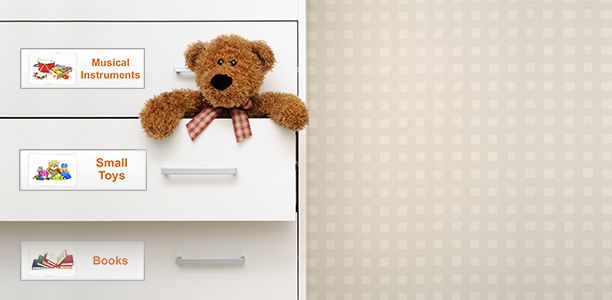Age
Two years and over
Duration of activity
This activity should make cleaning up after play a little quicker than it used to be and will also teach children a range of educational skills.
Materials/equipment
- Toy labels – we have created a large variety of toy labels in multiple languages, but there are also blank labels available below.
- Printer and electronic pictures of toys OR pictures of toys, glue and coloured pens
- Laminator and laminating pouches
- Blu-tac
Cost
Making toy labels shouldn’t cost more than a couple of dollars.
Preparation
- Print toy labels in your language (or print in two languages if teaching your child a second language).
- If you have toys which are not included in the labels, let us know so we can add them to the list. Or create your own by finding pictures of your child’s toys online (Google them or find them in the online version of the toy store where you bought them) and paste them into our blank labels. Type the name of the toy underneath. You could also find the pictures in magazines or catalogues and cut them out with scissors and paste them onto the template and write clearly what the toy is. You could even use pictures of your child holding different types of toys, but you may need to resize them to fit.
- Laminate your toy labels and cut them out.
- Place a piece of blu-tac on the back of each card.
- Stick the labels in the places your child keeps toys (or where you would like them to keep their toys). For example you could stick the books label on their bookshelf and puzzles label on the box they keep all their puzzles in. You can label toys boxes, shelves or just about anything else- it’s a great way to organise a room.
What to do
- Show your child the labels and explain that each label marks a spot where they keep a certain kind of toy. Explain that you would like them to start putting their toys in the places where the labels are when they finish playing.
- Point to each label and ask your child what sort of toys they should put near it. Even if they are too young to read, they will probably be able to pretend to read, using the pictures as a guide.
- As your child ‘reads’ the label, help them by pointing at the words, showing them the first letter and helping them sound out the letters (or sounding them out yourself) as you move your finger across the word from left to write.
- When your child takes their toys out to play, remind them that when they finish playing, they will need to find the correct spots to put them away in, using the labels.
- When they finish playing, ask them to put the toys away where they belong, for example by saying, “Now that you’ve finished playing with this puzzle, can you put it in the space for puzzles? Can you see the label for puzzles?”
- Help your child to find the correct label and read it, sounding out the words and looking at the pictures.
- When they’ve finished packing up their toys, explain to them that you’d like them to do the same thing each time they finish playing. Tell them that even when you are not there to help them, they can use the labels to pack up their toys all their own.
Tips
- Give your child plenty of space to try and work the labels out for themselves. For example be in the room to help, but wait until your child asks for help, don’t offer it. Ultimately this activity should teach them to tidy up independently, so each time you do a tidy up, give them a little bit more responsibility.
- You can also make labels for other items your child uses frequently, for example make labels for bathroom objects like toothbrush and soap, or different items of clothing (e.g. sock drawer, underwear drawer).
- If your child puts something in what seems like the wrong place (e.g. construction bricks with the puzzles) talk to them about why they put the toy there. They probably have a reason for doing it and discussing with them will help you both understand where different toys should go.
- As your child tidies up their toys, make specific comments about their efforts and accomplishments.
- Use tidying up time as an opportunity to enhance your child’s mathematical skills by counting the toys as they put them away, talking about the colours, using comparative words like big and small or location words like left/right, beside and above.
Extension activities
- Make toy labels in multiple languages to teach your child a second language.
Educational outcomes
Self-awareness and self-regulation
Tidying a room with toy labels teaches your child to be responsible for their belongings and gets them in the routine of cleaning up after themselves. The labelled room is a space in which they can take responsibility independently of you, by packing up their toys on their own. Although they may need your help to read the words, children will be able to work out which toys go where using the pictures on the labels to guide them. Developing independence is an important part of child development in the early years, as is learning to follow rules and routines. Providing opportunities for your child to work independently, as well as simple rules they can following while going about their routines, are great ways to help your child develop.
Problem solving
When working out which toys go where, your child will also develop their problem solving skills. Providing opportunities for them to solve problems is an important thing for parents to do to help their children master problem solving.
Motor skills
Picking up and putting away toys will also help your child develop their motor skills. Any small objects they need to lift will help develop the small hand muscles that work the fingers. Walking around the room, bending down or reaching up to put toys away will help develop their gross motor skills, that is the skills needed to coordinate movements of the big muscles which control the arms, legs and other large body parts.
Communication and social skills
Your child will be practicing speaking and listening as they tidy their toys and developing a better understanding of the rules of conversation (e.g. taking turns and answering when asked). Speak in clear, simple sentences when giving them instructions and use words that they understand. Give them an opportunity to try using new words and pronouncing them correctly.
Language and literacy skills
Toy labels are a great way to develop your child’s awareness of the relationship between words and objects, that words represent pictures. Sounding out the printed words will help them learn the alphabet, recognise the shape of each letter and the sounds which go with them. Do things like pointing at the words and asking, “what does this say?” and pointing to the different letters as they sound out the words will help them learn.
Maths skills
Putting different types of toys near their labels is also helping your child learn about sorting and classifying objects, an important mathematical skill. Counting toys as you put them away, or discussing their shape, size, colour or location can also increase your child’s understanding of mathematical concepts and develop their mathematical vocabulary.
Toy labels download
Toy labels
Craft labels
Stationary labels
Images only (write in your own language) Please share your language with us
Blank labels (add in your own pictures and descriptions for those that aren’t included here). Tell us what you think we should add
References
- Virginia Early Childhood Development Alignment Program. Milestones of child development- A guide to young children’s learning and development from birth to kindergarten. 2009. (cited 12 January 2014). Available from: (URL Link)



 (9 votes, average: 4.56 out of 5)
(9 votes, average: 4.56 out of 5) 






